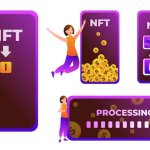The world of digital goods and art has undergone a change thanks to non-fungible tokens (NFTs). Although Ethereum has been the most widely used blockchain for NFT production and trading, investors and developers are now looking into other options because to growing gas prices and network congestion. This thorough tutorial explores the process of minting NFTs on blockchains other than Ethereum, each with its own special benefits.
NFT Minting: What Is It?
Digital data are transformed into cryptocurrency collectibles or digital assets on a blockchain by minting an NFT. A digital certificate of ownership is produced by the procedure and can be purchased, exchanged, or sold. Below we are going to talk about the different types of NFT minting, why you should consider using each and how to use.
Binance Smart Chain (BSC) Minting
In comparison to Ethereum, Binance Smart Chain promises faster speeds and lower transaction fees. It’s becoming a well-liked option for producers searching for efficiency and economy.
How to Mint Using BSC:
- Establish a Wallet: Create a Binance wallet or use one that works, such as MetaMask.
- Obtain BNB: To cover transaction fees, purchase Binance Coin (BNB).
- Select a Platform: Pick an NFT marketplace with a BSC foundation, such as Treasureland or BakerySwap.
- Upload Your File: To upload your digital file, follow the platform’s instructions and include information about it, such as a title, description, and royalties.
- Mint Your NFT: Pay the gas fee in BNB to finish the minting process.
Flow Blockchain Minting
Flow, created by Dapper Labs, the same team that brought us CryptoKitties, is effective for NFTs and decentralized apps (dApps) since it is built for large scaling without sharding.
How to Create a Flow Wallet and Mint on Flow:
- Set Up a Flow Wallet: Utilize the Dapper or Blocto wallet.
- Obtain Flow Tokens: To offset transaction costs, buy Flow tokens.
- Choose a Market: Look for a marketplace, such as NBA Top Shot or VIV3, that offers Flow support.
- Upload and Mint: Using the Flow blockchain, upload your asset, complete the information, and mint your NFT.
Minting on Tezos
The blockchain Tezos is renowned for being energy-efficient and having a small carbon impact. For artists and innovators who care about the environment, its reduced gas costs make it a desirable platform.
How to Mint Using Tezos:
- Tezos Wallet: Construct a Tezos-compatible wallet, like Temple or Kukai.
- Get XTZ Tokens: Purchase Tezos (XTZ) to be used as payment for gas.
- Select a Marketplace: Make use of Kalamint or Hic et Nunc, two Tezos-based platforms.
- Mint Your Artwork: Use XTZ to mint your NFT after uploading your digital file and adding the required information.
Minting on Solana
High-frequency trading and projects involving a lot of NFTs are best suited for Solana because of its exceptional throughput and cheap transaction costs.
How to Mint Using Solana
- Solana Wallet: Create a Solana wallet, like Sollet or Phantom.
- Get SOL Tokens: For costs, purchase Solana (SOL) tokens.
- Choose an NFT platform with a Solana basis, such as Metaplex or Solsea.
- Upload and Mint: Submit your file and pay the required amount in SOL to finish the minting procedure.
Polygon (Matic) minting
For creators looking for Ethereum security without the drawbacks, Polygon (previously Matic Network) is a great choice because it provides Ethereum compatibility with faster speeds and reduced fees.
How to Mint Using Polygon
- Wallet Compatible with Ethereum: Make use of wallets like Trust Wallet or MetaMask.
- Acquire MATIC Tokens: Acquire MATIC to cover transaction costs.
- Marketplace Choices: Select OpenSea or other platforms that allow Polygon.
- Mint Your NFT: Mint on Polygon by following the guidelines provided by the marketplace.
Questions to Ask When Selecting a Blockchain
Transaction Fees: Examine gas costs across blockchains; this is crucial if you mint frequently or on a large scale.
Features of Blockchains: Evaluate each blockchain’s scalability and technical aspects.
The availability of active marketplaces that support the blockchain of your choice is a crucial consideration.
Community and Ecosystem: To maximize visibility and sales potential, take into account the size and activity of each blockchain’s community.
Impact on the environment: The blockchain’s energy efficiency may be a deciding factor for producers who care about the environment.



